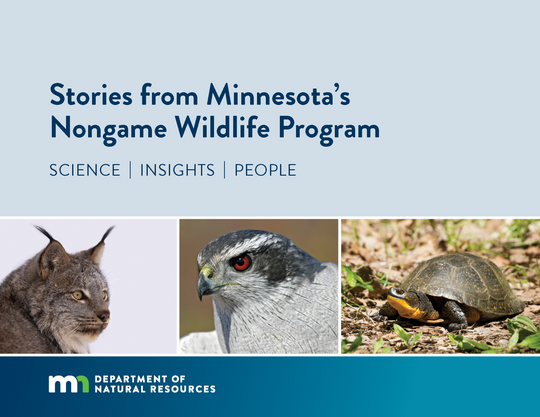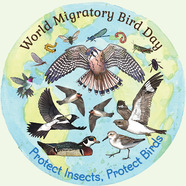|
Spring, 2024
 We are so excited to release our newest publication, “Stories from the Nongame Wildlife Program.”
“Stories from the Nongame Wildlife Program” features seven wildlife conservation projects made possible thanks to your support. From the re-launch of the popular Frog and Toad Calling Survey to monitoring salamanders, these stories dive deep into our work and the people who make it possible.
We would not be able to accomplish any of this conservation work without your support. Thank you for your dedication to Minnesota’s rare and vulnerable wildlife.

The peregrine falcons on our FalconCam have an active nest and they are currently incubating eggs. This spring, the webcam captured them demonstrating courtship displays and they laid their first egg on April 11. DNR staff confirmed the presence of a second egg on April 13, a third on April 17 and the fourth and final egg on April 20.
Eggs could begin hatching as early as this week. Until then, the male and female will alternate incubating the eggs. The female does most of the incubation, but when she leaves for a break, the male will fly in and take his turn.
The two adult falcons using this nest box have been identified by the Midwest Peregrine Society as an eleven-year-old female and a fifteen-year-old male. This female falcon has nested in this box since 2016. The male, banded as a chick in 2009 in Indiana, is a new partner for the female.
|

As you’re working on your gardens, consider adding native plants to the mix 🌼
Native plants will attract butterflies, bumble bees, birds and other wildlife to your backyard or balcony, while also helping them thrive by providing essential food and shelter.
Audubon has a great list of bird-friendly plants and the University of Minnesota Extension has you covered for pollinator-friendly plants.
|

Did you know there are tigers in Minnesota? 🐅
Tiger salamanders that is! These large, black and yellow salamanders are the most common salamander found in Minnesota, but often go unnoticed due to their secretive lifestyle.
They spend most of their life underground in burrows created by mammals or rotted tree roots, surfacing at night to feed on worms, snails and insects. They are most commonly found in the spring as they migrate to their breeding ponds.
Learn more about Tiger salamanders (and Minnesota’s other salamander species) in the Minnesota Conservation Volunteer.
Photo by USFWS
|

Break out your binoculars, the Twin Cities Urban Bird Festival is happening this month!
From May 17-19, there will be over 30 bird-themed events and activities happening all over the Twin Cities to celebrate spring migration and World Migratory Bird Day. There will be opportunities for all ages and birding experiences, so there’s something for everyone.
Our program is partnering with Wood Lake Nature Center to host two bird walks on Sunday, May 19 as part of the celebration. DNR staff will lead a bird bingo walk that’s geared for families and a more classic bird walk. Binoculars will be available for loan, but if you have a pair, we encourage you to bring them.
Both guided walks start at 9 a.m. and are free to attend. Space is limited, so pre-registration is required. Check out our events for more information:
Bird Bingo (great for ages 7 and up)
Guided Bird Walk (best for ages 15 and up)
Photo by World Migratory Bird Day
|
Spring is an exciting season, but it can also be a dangerous time for birds. With migration and the mating season underway, birds are very active and vulnerable to window collisions. It’s estimated that these strikes kill up to 1 billion birds in the United States each year, but there are simple ways you can help:
🌃 Lights out at night: A majority of migrating birds travel at night, using stellar navigation. As they pass urban areas, they can become disorientated by city lights, leading them to fly in circles causing exhaustion and leaving them vulnerable to urban threats. They might drop to the ground, putting them at risk of predators and cars. They might also collide with glass windows. Turning off your unnecessary lights at night- especially exterior lights- reduces light pollution and helps migrating birds stay on route.
⭐Make windows obvious: Help prevent window strikes by modifying your windows to break up their reflection. Birds don’t perceive window reflections as an obstacle, but rather see them as more sky, trees or shrubs to fly toward. To reduce reflection and help show birds that your window is a hard structure, put up window clings and decals, hang string in front of the glass or cover the outside of the window with mesh.
🥜 Safe feeder placement: If you have a bird feeder, follow the “Rule of 3 or 30”. Place your feeder either within 3 feet of a window or farther than 30 feet away from the window. When birds take off from a feeder that is within 3 feet of a window, they are less likely to strike it at high speed. Even more effective is placing the feeder 30 feet or more away from a window, which will give them plenty of room to maneuver.
Check out Audubon’s Project BirdSafe for more information on how you can help Minnesota’s migrating birds.
|
🎶 The hills are alive, with the sound of bird song 🎶
If you’ve been hearing a lot of birds singing lately, you’re not alone! Male birds are looking for mates and establishing their territories.
Want to learn who’s singing by your home? The Minnesota Conservation Volunteer has a great interactive bird song poster of some common bird species. Simply click on the illustrated bird and enjoy their song.
Listen here: mndnr.gov/mcvmagazine/bird_songs_interactive.html
|
|
 |
|